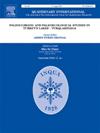过去600年印度季风的变化
IF 1.9
3区 地球科学
Q3 GEOGRAPHY, PHYSICAL
引用次数: 0
摘要
Siwalik山是喜马拉雅前陆盆地的一部分,主要在印度夏季风(ISM)季节降水,是印度北部季风变化的重要因素。为了了解过去六个世纪的季风强度,我们分析了Sherla湖的代理记录,Sherla湖是位于印度北部哈里亚纳邦的一个封闭湖泊。沉积物的年代学基于5个放射性碳AMS 14C测年,涵盖了最近的~ 600年。在这些代用物中,我们分析了大块沉积物样品(碳酸盐和有机)的稳定同位素(δ18Ocarb、δ13Ccarb、δ15N和δ13COM)、粒度分布(GSD)和地球化学参数(CaO%、Rb/Sr和Si/Ca比)。Sherla湖数据揭示了自小冰期(LIA) (~ 1360-1750 CE)到当前暖期(~ 1850 CE至今)的显著变化。从~ 1360 ~ ~ 1500 CE (LIA的早期阶段),代理数据表明,研究区域的蒸发条件较多,湿润条件较少,能量条件较低,集水区有限的风化证实了这一点,表明ISM较弱,C3和c4型植被混合。从~ 1600 ~ 1780 CE (LIA后期),多代理参数表明降水在高能量条件下更加稳定,集水区风化增强,c3型植被增加,反映了这一时间段的湿润条件。光谱分析表明El Niño-Southern涛动(ENSO)和太阳强迫对印度季风有显著影响。喜马拉雅山麓降水的增加可能是由于印度核心季风区在ENSO活动增加期间发生了更多的断裂事件。在低气压后期,喜马拉雅山麓地区冬季降水在很大程度上受北大西洋涛动(NAO)指数强度变化的控制,因此研究区在冬季获得了显著的水汽。本文章由计算机程序翻译,如有差异,请以英文原文为准。
Indian monsoon variability during the past 600 years
The Siwalik hills, part of the Himalayan foreland basin, receive precipitation mainly during the Indian summer monsoon (ISM) season and are an important factor for monsoon variability in northern India. To understand monsoon strength during the past six centuries, we analyzed proxy record from the Sherla lake which is a closed lake located in the northern state of Haryana, India. Chronology of the sediment is based on five radiocarbon AMS 14C dates, encompassing the last ∼600 years. Among proxies, we have analyzed stable isotope ratios (δ18Ocarb, δ13Ccarb, δ15N and δ13COM) in bulk sediment samples (carbonate and organic) along with grain size distribution (GSD) and geochemical parameters (CaO%, Rb/Sr and Si/Ca ratios). The Sherla lake data reveal significant changes since the Little Ice Age (LIA) (∼1360-1750 CE) to the Current Warm Period (∼1850 CE to the Present). From ∼1360 to ∼1500 CE (early phase of the LIA), the proxy data indicate more evaporative and less humid conditions along with low energy conditions corroborated by limited catchment weathering in the study area which suggests a weak ISM with mixed C3- and C4-type vegetation. From ∼1600 to ∼1780 CE (later phase of the LIA), multi-proxy parameters suggest that precipitation was more stable with high energy conditions along with enhanced catchment weathering and increasing trend of C3-type vegetation, reflecting moist and wet conditions during this time slice. Spectral analysis of different proxies suggests prominent influence of El Niño-Southern Oscillation (ENSO) and solar forcing on Indian monsoon. Increased precipitation over the Himalayan foothills may have resulted from more break events in the core monsoon zone in India during periods of increased ENSO activity. During the later phase of the LIA, the study area received significant moisture during winter months as the winter precipitation over the Himalayan foothill region is largely controlled by the changes in the intensity of North Atlantic Oscillation (NAO) index.
求助全文
通过发布文献求助,成功后即可免费获取论文全文。
去求助
来源期刊

Quaternary International
地学-地球科学综合
CiteScore
5.60
自引率
4.50%
发文量
336
审稿时长
3 months
期刊介绍:
Quaternary International is the official journal of the International Union for Quaternary Research. The objectives are to publish a high quality scientific journal under the auspices of the premier Quaternary association that reflects the interdisciplinary nature of INQUA and records recent advances in Quaternary science that appeal to a wide audience.
This series will encompass all the full spectrum of the physical and natural sciences that are commonly employed in solving Quaternary problems. The policy is to publish peer refereed collected research papers from symposia, workshops and meetings sponsored by INQUA. In addition, other organizations may request publication of their collected works pertaining to the Quaternary.
 求助内容:
求助内容: 应助结果提醒方式:
应助结果提醒方式:


